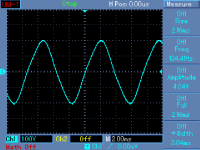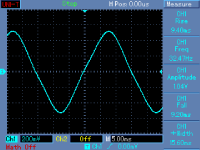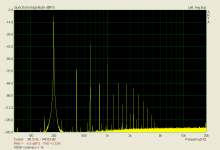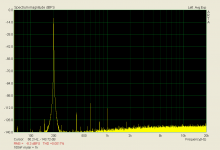Could there not be a nonlinear element with the real source of DA?
No one has shown that to be true. Dick is claiming it's true, but can't remember why.
Fashion audio is endlessly entertaining.
So, you can set a 1KHz low pass filter to an audio signal with no consequences ? It changes the harmonic contents of an audio signal. So it is a kind of distortion, on a etymological point of view.Linear combination of linear elements, so... no.
PMA said-it in a better way than I:
Harmonic. When I write "distortion", I mean non-linear distortion. In case I want to distinguish both, I write "linear distortion" (amplitude, phase, time response) and "non-linear distortion" (new harmonic components created). Initial change of time response is not any non-linear distortion.
Last edited:
He did not "claims". Just proposed as an explanation. 30 years ago. You are more than welcome to propose a better and more accurate hypothesis.Dick claims that it does.
While the lack of elegance of some "anti fashion" techs is not.Fashion audio is endlessly entertaining.
Last edited:
He did not "claims".
Yes, he did. On several occasions. Even said that the DA models needed to be revisited to include the distortion he "claimed" was due to DA.
se
Hi Pavel
Have you had a listening session?
Have you (technically) tested it?
Silver mica is one of the worst capacitors regarding DA. But it is appreciated by audiophiles. How is it possible?
Memories. Mica speckles silvered on both sides were used as tank capacitor inside IF filter assy cans in 60ies and 70ies table top radios. After 2-3 decades, silver migrated shorting the caps.
I have an oil cap charging, I want to see how much voltage returns after discharge,
...
Of course there is taste involved.
~ What's all this Trapped Charge and Dielectric Compression stuff anyhow? ~
~ Further tests for Dielectric Compression in Capacitors ~
Let us not forget beeswax/paper/foil, someone actually went back into production making them.
I am sure there is a market gap for this (old gear restoration)
So what really is DA ?.
A cap can be shorted for a relatively long period and then return a voltage ramp.
Why ?.
Dan.
Dielectric absorption - Wikipedia, the free encyclopedia (plus the References)
Dielectrics are insulators, but they're not perfect insulators. And some of those electrons on the negative plate will slowly move into the dielectric. Sort of like a sponge, which is why DA is also referred to as "soakage."

This is a black sponge among the white DA sponges
George
Look, this is the ceramic cap (I have shown yesterday distortion plot), C-R 100nF+1.6kohm, above any words. Input is clean sine.
Voltage excursion across the cap is significant, and distortion looks symmetrical.
I suspect this distortion is due to voltage-dependend capacitance reduction on a MLCC with no DC-Bias applied
Please could you give the exact type of cap, or at least its blocking voltage?
Last edited:
Tesla TK683, 100nF, 32V. The type probably does not help much.
This is the distortion plot at much lower voltage. The distortion is only roughly symmetrical, from scope screen. Spectrum shows it has all components.
This is the distortion plot at much lower voltage. The distortion is only roughly symmetrical, from scope screen. Spectrum shows it has all components.
Attachments
Last edited:
Hi Pavel
Have you had a listening session?
Have you (technically) tested it?
Yes, I have visited a studio and listened about one hour. No chance to measure, however.
the Pease article is getting harder to find free and complete - my archive.org link has lost the last half of the paper
Is this the right one?
Understand capacitor soakage to optimize analog systems nsc03883 - Datasheet Archive
true context is polar vs film
Lets go back to square one for a moment (groans) : The test article of 30 years ago was about DA and capturing its recovery from Cda is about polar vs film. Get that straight first. It isnt about film vs film. It isnt about thd of caps dielectrics. I showed electrolytic and tantalum and monolythic ceramic (1 or 2mfd/50v) as will as film for DA comparison.
The issue that this applied to was this -- what is it about using polar caps that could cause it to sound like compressed and loss of detail or as one called it... inter-transient silence was obscured or filled in. That same person (in Berkeley, CA) had previously did high res waveform sampling and compared the signals direct and thru caps.... the stored and compared waveforms had signal valley of the signal was filled in more than with no cap. And peaks reduced. He used music signals of transient nature to capture and not sine waves.
The DA affect does this most grievously in polar caps. The 2H distortion I measured was also related to polar caps. Specifically, cheap-o consumer electrolytics. And, when films were used, the sound cleared up compared to polar types. All this about films in isolation to polar is off the mark. Most any film beyond mylar is close to perfect unless you had a string of them to remove and compare.
Now, the DA storage affect can be increased or decreased depending on the external circuits Z. I showed that as well.... and if you think about it, you can all but eliminate any affect due to DA by using short time constants.... low noise is typical. Low Z source and loads. At the time of tube circuits and newer ss... input Z were higher -- 470K, 150K and 100K were more typical and that exposed DA waveform... linear... affects - but audible as a distortion (change) of the original sound --compared to no cap. Now we use, hopefully, 10K max for ss or even 600Ohms and non-linear input Z for a load just complicates the sorting of what is the contributor when it is several.
To recap, harmonic distortion of polar caps is real and measureable, from films it is insignificant IMO for any primary reason. DA from polar caps is real and measureable and audible as harm. distortion and change of the fine structure of the asymetrical waveform and its internal Z isnt always linear and the diode of course of the polar is always a concern. Biasing polar caps and many other work arounds to keep a polar cap from distorting isnt necessary. Just dont use them unless you are counting parts..... then a circuit like this one will do just fine for most people -->
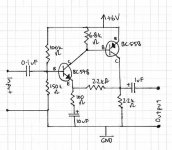
When polars are not used as in direct dc coupled or thru films, that inter-transient silence returns. Also, more lately, the terms described as more detailed, more dynamic, etc. The tests by myself and others point to DA.
THx-RNMarsh
Dick claims that it does.
Lets go back to square one for a moment (groans) : The test article of 30 years ago was about DA and capturing its recovery from Cda is about polar vs film. Get that straight first. It isnt about film vs film. It isnt about thd of caps dielectrics. I showed electrolytic and tantalum and monolythic ceramic (1 or 2mfd/50v) as will as film for DA comparison.
The issue that this applied to was this -- what is it about using polar caps that could cause it to sound like compressed and loss of detail or as one called it... inter-transient silence was obscured or filled in. That same person (in Berkeley, CA) had previously did high res waveform sampling and compared the signals direct and thru caps.... the stored and compared waveforms had signal valley of the signal was filled in more than with no cap. And peaks reduced. He used music signals of transient nature to capture and not sine waves.
The DA affect does this most grievously in polar caps. The 2H distortion I measured was also related to polar caps. Specifically, cheap-o consumer electrolytics. And, when films were used, the sound cleared up compared to polar types. All this about films in isolation to polar is off the mark. Most any film beyond mylar is close to perfect unless you had a string of them to remove and compare.
Now, the DA storage affect can be increased or decreased depending on the external circuits Z. I showed that as well.... and if you think about it, you can all but eliminate any affect due to DA by using short time constants.... low noise is typical. Low Z source and loads. At the time of tube circuits and newer ss... input Z were higher -- 470K, 150K and 100K were more typical and that exposed DA waveform... linear... affects - but audible as a distortion (change) of the original sound --compared to no cap. Now we use, hopefully, 10K max for ss or even 600Ohms and non-linear input Z for a load just complicates the sorting of what is the contributor when it is several.
To recap, harmonic distortion of polar caps is real and measureable, from films it is insignificant IMO for any primary reason. DA from polar caps is real and measureable and audible as harm. distortion and change of the fine structure of the asymetrical waveform and its internal Z isnt always linear and the diode of course of the polar is always a concern. Biasing polar caps and many other work arounds to keep a polar cap from distorting isnt necessary. Just dont use them unless you are counting parts..... then a circuit like this one will do just fine for most people -->

When polars are not used as in direct dc coupled or thru films, that inter-transient silence returns. Also, more lately, the terms described as more detailed, more dynamic, etc. The tests by myself and others point to DA.
THx-RNMarsh
Last edited:
So, you can set a 1KHz low pass filter to an audio signal with no consequences ?
That's a non sequitur. Adding a linear filter does not increase harmonics nor add new ones. Dick saw new harmonics and attributed it to DA. That makes no sense, but if he can recall exactly how that connection was established, that would be interesting to know.
OK so how about...
If the "intertransient silence" degradation is supposed to be caused by DA of polar caps, why not construct a good-film-capacitor and resistor array, based on today's best DA models, that simulates the bad DA cap, and see if the effect in circuit is the same as the bad DA cap?
If the only effect is a change in time-domain and frequency-domain behavior, but no generation of additional harmonics, this strengthens the notion that DA per se does not create nonlinear distortion.
If the "intertransient silence" degradation is supposed to be caused by DA of polar caps, why not construct a good-film-capacitor and resistor array, based on today's best DA models, that simulates the bad DA cap, and see if the effect in circuit is the same as the bad DA cap?
If the only effect is a change in time-domain and frequency-domain behavior, but no generation of additional harmonics, this strengthens the notion that DA per se does not create nonlinear distortion.
IOW, you haven't really done anything to assign the observed harmonic distortion to DA.
Apparently not by your definition for what you want to know. It could be related to DF in a similar way.... all strong circumstantial evidence for you down to as far as I need to go with it for audio apps.
THx-RNMarsh
If the "intertransient silence" degradation is supposed to be caused by DA of polar caps, why not construct a good-film-capacitor and resistor array, based on today's best DA models, that simulates the bad DA cap, and see if the effect in circuit is the same as the bad DA cap?
Yes, that would be a basic control experiment that a competent researcher would do. It would also pin down if there was an artifact in the test equipment that needed accounting for.
Great idea -
yes. That would have been easier than the hardware route I had to take. No free PC sim software at the time.... all on main-frame and mini (DEC).
Go for it!! I dont know why SY and SE havent tried it themselves long ago... or D.Self et al as he/they have good sim programs. Just model the DA and put a pulse thru it and you should get what my hardware showed and from there play with it. Please do it soon though.
It is a much better point to start debate on DA. You can model the complete polar cap as well ... like with circuits and put in all the 2nd and 3rd level items... then change I/O Z and look at changes. Lots of people can do it in sim besides argue about it.



If the "intertransient silence" degradation is supposed to be caused by DA of polar caps, why not construct a good-film-capacitor and resistor array, based on today's best DA models, that simulates the bad DA cap, and see if the effect in circuit is the same as the bad DA cap?
If the only effect is a change in time-domain and frequency-domain behavior, but no generation of additional harmonics, this strengthens the notion that DA per se does not create nonlinear distortion.
yes. That would have been easier than the hardware route I had to take. No free PC sim software at the time.... all on main-frame and mini (DEC).
Go for it!! I dont know why SY and SE havent tried it themselves long ago... or D.Self et al as he/they have good sim programs. Just model the DA and put a pulse thru it and you should get what my hardware showed and from there play with it. Please do it soon though.
It is a much better point to start debate on DA. You can model the complete polar cap as well ... like with circuits and put in all the 2nd and 3rd level items... then change I/O Z and look at changes. Lots of people can do it in sim besides argue about it.
Last edited:
Yes, that would be a basic control experiment that a competent researcher would do. It would also pin down if there was an artifact in the test equipment that needed accounting for.
yep... could even be an non-linear input Z of the S/H FFT /scope analyzer loading the Cap DUT? Right? I only bring it up a a side comment/issue.
That is why I did not put it in my IEEE presentation... but added it -off the cuff-after being asked.
THx-RNMarsh
Last edited:
Talk about short term memory ... Richard a day ago clearly stated that this is not the case, to no avail ...Dick Marsh claims that he does, but he forgot what they were. So see if you can jog his memory.
But what's the fun if you can't keep claiming something, accompanied by cheers and jeers from the crowd, that stands high over nothing at all - like poor, Wile E. Coyote
Last edited:
- Status
- Not open for further replies.
- Home
- Member Areas
- The Lounge
- John Curl's Blowtorch preamplifier part II
